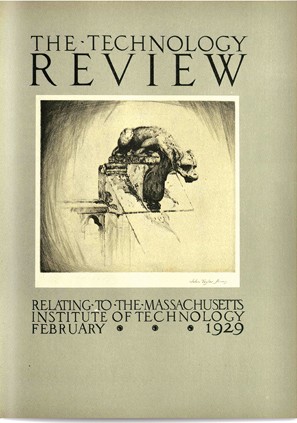Chemical Reaction
From “Facts and Fancies about Gas Warfare,” originally published in the February 1929 issue of Technology Review.
“Deadly gases purported to have sufficient toxicity to wipe out whole cities are periodically discovered, according to the public press, and it has grown to be the great indoor sport of a school of front-page chemists to draw horrific pictures of the use of gas in the next war. A ready-made example of this is a public statement from Hilton Ira Jones of Chicago, listed in the Directory of the American Chemical Society as Director of Scientific Research, The Redpath Bureau. He is quoted as asserting that the Government possesses knowledge of a new gas, believed by him to be cacodyl isocyanide, which is so overwhelmingly deadly that the Chemical Warfare Service of the Army has attempted to suppress discussion about it.

At best Dr. Jones’s statement is an ill-informed outburst, adding to public fear and misunderstanding of lethal gases and their military uses. It is a generally accepted maxim among informed chemists and physiologists that no gas exists at the present time (nor will one be discovered) against which some means of protection and defense may not be devised. Professor James F. Norris, former President of the American Chemical Society, in talking recently of the development and use of war gases, stated that the gas referred to by Dr. Jones was tested exhaustively by the Germans during the World War but was not used by them. Dr. Norris, who was in charge of offense chemical research and war gas investigating for the United States Government during the war and is now a consultant for the Edgwood Arsenal, holds that the Allies were also familiar with the cacodyl group and found it unsatisfactory.
Moreover, as Dr. Norris points out, it is improbable that more deadly and toxic gases will be discovered; enough sufficiently lethal gases are already known. Asphyxiant gases such as phosgene and blistering gases such as mustard gas will certainly kill if they make contact in sufficient quantities. Instead, the probable trend of gas warfare studies will be toward finding more effective means of using these known gases against the increasing effectiveness of methods to combat them, and in the development of so-called neutralizing gases which incapacitate rather than kill. Anyhow, it is patently absurd to say that any gas could be used in quantities sufficient to annihilate whole populations and altruism of the sort imputed by Dr. Jones would be obviously incompatible with faithful adherence to the responsibilities the Republic has entrusted to its Chemical Warfare Service.”
Keep Reading
Most Popular
Large language models can do jaw-dropping things. But nobody knows exactly why.
And that's a problem. Figuring it out is one of the biggest scientific puzzles of our time and a crucial step towards controlling more powerful future models.
How scientists traced a mysterious covid case back to six toilets
When wastewater surveillance turns into a hunt for a single infected individual, the ethics get tricky.
The problem with plug-in hybrids? Their drivers.
Plug-in hybrids are often sold as a transition to EVs, but new data from Europe shows we’re still underestimating the emissions they produce.
Stay connected
Get the latest updates from
MIT Technology Review
Discover special offers, top stories, upcoming events, and more.